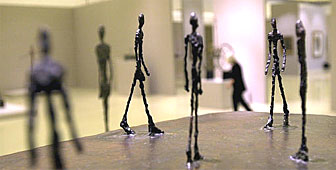Alberto Giacometti: a single-minded passion

Alberto Giacometti, the sculptor and painter who was born 100 years ago in Canton Graubunden, uncompromisingly depicted what he saw, and has emerged as one of the most significant artists of the century.
“What I want is to reproduce my vision of things as accurately as possible”, he told Radio della Svizzera Italiana in 1956. “Nothing more, nothing less.”
He was born on October 10, 1901 at Borgonovo, in Val Bregaglia. His father was the painter Giovanni Giacometti, his mother, Annetta. Encouraged by his family, he began to draw and sculpt at a very young age, demonstrating a precocious talent.
After some years at the Protestant college in Schiers, in Canton Graubunden, he decided to study art, first in Geneva, then in Paris. Paris became his second home, though the bond with his family – especially his mother – and his native valley remained a powerful factor in his life. He returned regularly to Stampa, the village to which his parents had moved a few years after his birth.
Artistic experiments
In Paris, he soon came into contact with the major artists and intellectuals of the period. He experimented with Cubism, flirted for some years with Surrealism, and then in the mid-1930s rekindled his interest in drawing the human figure.
He intensely researched his craft. In the years from 1937 to 1947, his sculptures became smaller and smaller, to the point that he could carry some in match-boxes. The sculptures became larger again, but remained attenuated, stick-like, and skeletal.
The figures from this period, such as “Walking Man”, are probably Giacometti’s best-known works. They later regained a sense of volume and heft. All the while, he was producing paintings, drawings and writings.
In the mid-1950s, fame caught up with Giacometti. His works were exhibited more and more frequently, in Europe and the United States. He was not particularly bothered, continuing to live and work in his small, shabby workshop in Paris, in the Rue Hypolite Maindron.
In the early 1960s, however, his health began to suffer from his irregular lifestyle, overwork and, possibly, the stress of being famous. At the end of 1965, he was admitted to hospital in Chur, the main town of Graubunden Canton, dying there on 11 January 1966. A few days later, he was buried at Borgonovo, the village of his birth.
View through history
“When Giacometti works on a figure, he tries to emphasise just what he sees”, explained the art historian Jean Soldini, “doing away with every preconceived idea, every pre-constituted image. Essentially, he is repeating the lesson of Cézanne, who maintained that our task is to render the image of what we see, forgetting everything we have seen previously.”
This was a constant preoccupation of Giacometti’s labour as an artist, from the minuscule sculptures of the 1930s and ’40s to the period of his maturity. And to some extent it also underlay his Surrealist phase, notwithstanding the apparent formal break in the artist’s work around 1934.
According to Soldini, it was in the years that Giacometti was toying with Surrealism that the foundations for a return to the figure, to visible reality, were laid: “From beneath the wave of adventure, chance and life with all its surprises – a focus which is fundamental to Surrealism – the presence of things was beginning to surface again.”
It was indeed for life – the springing up of life – that Giacometti experienced so powerful a passion. This was the engine of his on-going struggle with his raw material, be it clay, plaster or paint, as he sought to snatch from it something approaching the truth he saw with his eyes.
His own words seem a fitting memorial: “As free as possible to attempt – with the instruments I have made my own – to see better, to understand better the things around me, to understand better in order to be as free and as large as possible, to spend, and spend myself to the utmost in what I do, to live out my adventure, to discover new worlds, to wage my war – for the pleasure of it?
“For the sheer joy of warfare? For the pleasure of winning and losing.”
by Andrea Tognina

In compliance with the JTI standards
More: SWI swissinfo.ch certified by the Journalism Trust Initiative
You can find an overview of ongoing debates with our journalists here. Please join us!
If you want to start a conversation about a topic raised in this article or want to report factual errors, email us at english@swissinfo.ch.